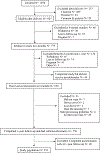Postpartum sedentary behaviour and pelvic floor support: A prospective cohort study
- PMID: 37055921
- PMCID: PMC10191970
- DOI: 10.1080/02640414.2023.2202063
Postpartum sedentary behaviour and pelvic floor support: A prospective cohort study
Abstract
We evaluated the association between sedentary time and pelvic floor support in primiparas delivered vaginally. The 532 participants (29.2 ± 4.9 years) wore wrist accelerometers 6 months postpartum to assess sedentary time, light physical activity (LPA) and moderate to vigorous physical activity (MVPA). We assessed pelvic floor support 1 year postpartum, considered worse if vaginal walls or apex prolapsed to or beyond the hymen. We used multivariable isotemporal substitution analyses to determine the prevalence of worse support when replacing sedentary time with equal time spent in either LPA or MVPA. In 1 year, 9.4% demonstrated worse pelvic floor support. Decreasing sedentary time by 30 min/day with a concomitant increase in MVPA, controlling for LPA, was associated with increased prevalence of worse support (PR 1.43 (95% CI 1.15, 1.77), P < 0.01). Decreasing the sedentary time by 30 min/day with a concomitant increase in LPA, controlling for MVPA, was not significant (PR 0.89 (95% CI 0.80, 0.99), P = 0.04, > pre-set alpha of 0.02). Increasing MVPA while decreasing LPA, controlling for sedentary time, also increased the prevalence of worse support (PR 1.66 (95% CI 1.28, 2.16), P < 0.001). In conclusion, decreasing sedentary time increased the prevalence of worse pelvic floor support when replaced by MVPA, but not LPA.
Keywords: Cohort; isotemporal substitution analysis; pelvic organ prolapse; physical activity; vaginal delivery.
Conflict of interest statement
Declaration of interest statement
The authors report there are no competing interests to declare.
Figures
Similar articles
-
Accelerometer-measured physical activity, sedentary behavior, and risk of incident pelvic organ prolapse: a prospective cohort study in the UK Biobank.Int J Behav Nutr Phys Act. 2024 Feb 2;21(1):12. doi: 10.1186/s12966-024-01559-w. Int J Behav Nutr Phys Act. 2024. PMID: 38308373 Free PMC article.
-
Early postpartum physical activity and pelvic floor support and symptoms 1 year postpartum.Am J Obstet Gynecol. 2021 Feb;224(2):193.e1-193.e19. doi: 10.1016/j.ajog.2020.08.033. Epub 2020 Aug 14. Am J Obstet Gynecol. 2021. PMID: 32798462 Free PMC article.
-
Reallocating Accelerometer-Assessed Sedentary Time to Light or Moderate- to Vigorous-Intensity Physical Activity Reduces Frailty Levels in Older Adults: An Isotemporal Substitution Approach in the TSHA Study.J Am Med Dir Assoc. 2018 Feb;19(2):185.e1-185.e6. doi: 10.1016/j.jamda.2017.11.003. Epub 2017 Dec 18. J Am Med Dir Assoc. 2018. PMID: 29269096
-
Isotemporal substitution of sedentary time with physical activity and its associations with frailty status.Clin Interv Aging. 2018 Sep 25;13:1831-1836. doi: 10.2147/CIA.S175666. eCollection 2018. Clin Interv Aging. 2018. PMID: 30288035 Free PMC article.
-
Device-measured physical activity, sedentary time, and risk of all-cause mortality: an individual participant data analysis of four prospective cohort studies.Br J Sports Med. 2023 Nov;57(22):1457-1463. doi: 10.1136/bjsports-2022-106568. Epub 2023 Oct 24. Br J Sports Med. 2023. PMID: 37875329 Review.
Cited by
-
How Active Are Women in the First Year of Motherhood? A Systematic Review of Device-Measured Physical Activity.Scand J Med Sci Sports. 2025 Aug;35(8):e70108. doi: 10.1111/sms.70108. Scand J Med Sci Sports. 2025. PMID: 40741718 Free PMC article.
-
Accelerometer-measured physical activity, sedentary behavior, and risk of incident pelvic organ prolapse: a prospective cohort study in the UK Biobank.Int J Behav Nutr Phys Act. 2024 Feb 2;21(1):12. doi: 10.1186/s12966-024-01559-w. Int J Behav Nutr Phys Act. 2024. PMID: 38308373 Free PMC article.
References
MeSH terms
Grants and funding
LinkOut - more resources
Full Text Sources
Medical
Research Materials
Miscellaneous


